Throughout history, many people actually drank, and still are drinking, their cider in the still form without carbonation.
Hard cider that has not undergone secondary bottle fermentation or force carbonation is called still cider.
It was the kind of cider that was made and consumed for hundreds of years before the glass bottle technology was strong enough for carbonation in the late 17th century.
Today, cider is associated with its fine bubbles, and still cider is a somewhat forgotten drink in many countries. However, the tradition of still cider is upheld in the northern parts of Spain, and by some craft breweries worldwide.
Some claim that still cider brings out more of the taste nuances of the cider, so maybe consider not carbonating your cider at all next time.
Is Hard Cider Always Carbonated?
While it’s true that many commercial ciders you find on the shelves are carbonated, not all ciders are fizzy.
Most modern ciders are carbonated, but some traditions, such as those in Asturias of northern Spain, value stillness.
Cidre de Asturias is a traditional non-carbonated or “still” cider that does not have carbonation.
You see, carbonation in cider is a result of a natural or intentional process. Some ciders undergo a process called “secondary fermentation,” where additional sugars are added to the fermented cider to produce carbon dioxide, creating those delightful bubbles we all love.
This is often done by adding priming sugar or introducing yeast before bottling. It’s a bit like the way champagne gets its fizz!
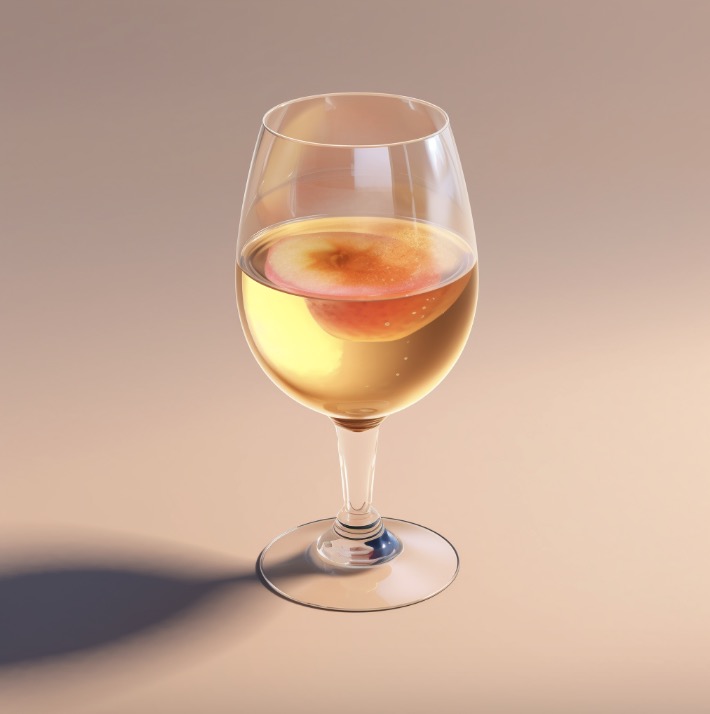
However, not all cider makers opt for carbonation. Some prefer to let their ciders rest and naturally settle over time, resulting in a still cider without any noticeable carbonation. These ciders can be just as delicious and enjoyable, with a smoother, more mellow character.
In fact, exploring still ciders can be a delightful adventure, allowing you to appreciate the cider’s true flavors without the distraction of bubbles. It’s like savoring a fine wine or a quality apple juice.
Of course, personal preference plays a significant role here. Some people love the effervescence and liveliness that carbonation brings to a cider, while others enjoy the calm and tranquility of a still cider. Luckily, the cider world is vast and diverse, offering something for everyone.
If you’re curious to try different styles, I’d suggest visiting local cideries or seeking out craft ciders that are known for their still varieties. You may discover hidden gems that captivate your taste buds in new and unexpected ways.
So, my friend, the bottom line is that hard cider can indeed be carbonated, but it’s not a requirement. Whether it’s bubbly or still, the most important thing is to enjoy the cider and savor every sip. Cheers to exploring the wonderful world of cider in all its diverse forms!
Why would you want to drink still cider?
The fizz of a cool freshly opened carbonated hard cider on a hot summer day is defiantly hard to beat, but there is more to its nonfizzy counterpart than you might think!
A still cider is exactly what white wine is to champagne, and it should be treated as such!
Without a layer of acidic tickling bubbles to hide behind, all the deeper taste nuances come forth and invite you deeper into the true notes of fermented apples.

It is as though a fog has lifted and the true nature of the apple appears in your mouth. Due to this very reason of clarity in taste, it is actually more challenging to make a good still cider compared to a carbonated one!
But for home brewers, it also presents the opportunity of creating a much different drink as we do not depend on the yeast to be alive (or active at least) at the time of bottling.
A result that can otherwise only be achieved using cold-crashing and wild yeasts or force carbonation after killing the yeast.
This means that we can add fresh fruit juice or additional sugars to give the depth of sweetness and fresh fruit back to the fermented drink.
Was hard cider always sparkling?
No! Cider has not always been fizzy or sparkling, it is a relatively new invention that took off in the 18th century.
Hard cider is often associated with the bubbles or fizz that resembles beer slightly more than champagne, but cider is not always carbonated.
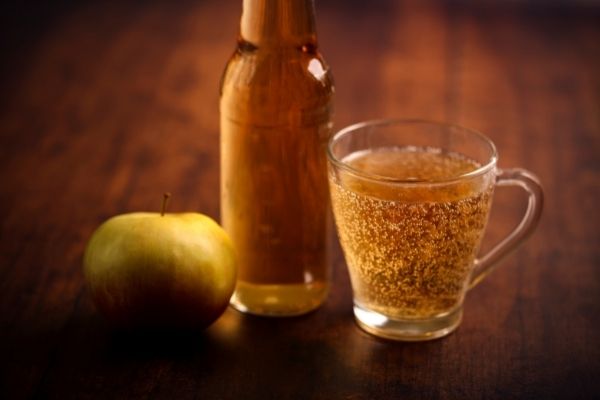
In fact, for the majority of hard cider’s history, the drink was enjoyed still, or without bubbles. And whereas the French cider tradition is quite strong on carbonation of their cider, the English and Spanish cider traditions have enjoyed still ciders for hundreds of years – and still do!
The carbonation tradition started relatively late in history, and whereas hard cider has likely been around for more than a thousand years, the carbonated version was invented some 400 years ago!
Sparkling cider was invented by English cider-makers who were experimenting with secondary fermentation in reinforced glass bottles sealed with corks in the late 16th century.
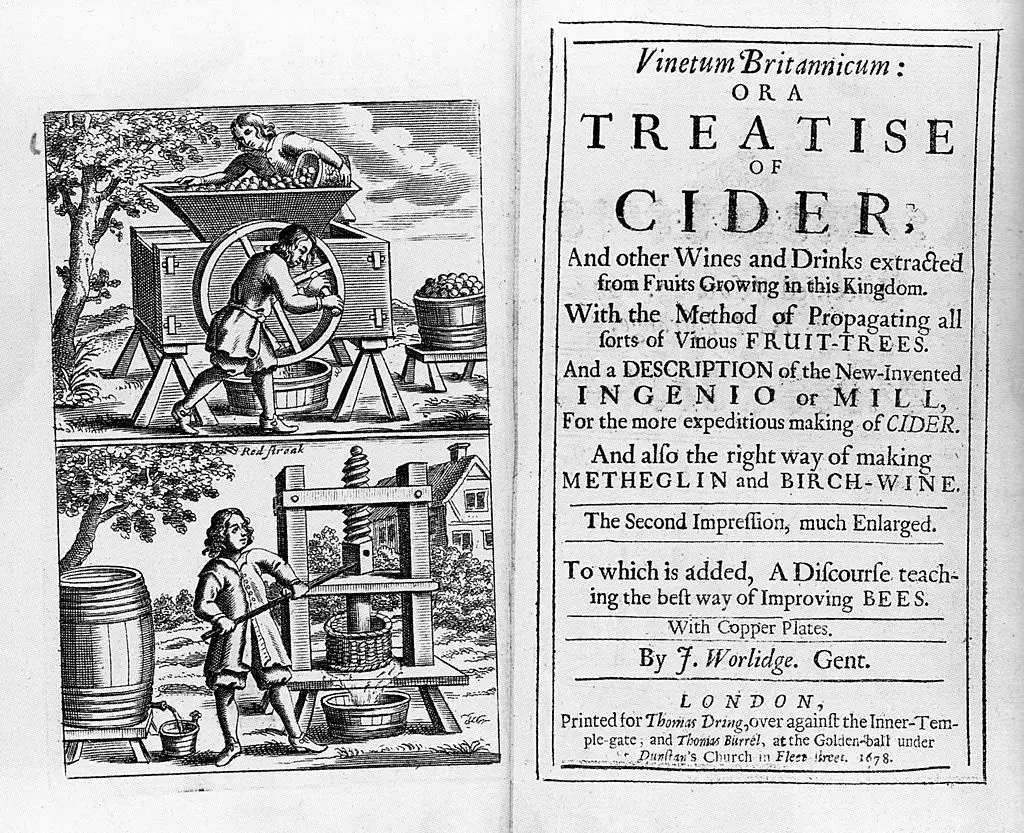
They may have done so even before the French invented champagne and the bottles used by the English cider makers were said to be stronger due to them using higher temperatures when melting glass for their bottles.
Can you get non carbonated cider?
Yes, there are many non carbonated ciders out there and they are even the main preference in some parts of Spain!

So, as mentioned earlier, all ciders used to be still before the invention of the thick champagne bottles we know today.
However, some parts of the world have so strong traditions associated with their original cider-making that they still prefer non-sparkling hard cider over sparkling ones.
This is, for example, the case for the cider drunk in Asturias of northern Spain. Cidre de Asturias is a hard held traditional cider that does not have carbonation.
In this region of Spain, it is not uncommon to drink the ciders without carbonation, but they do add a slight fizz to it in a different manner known as escanciado.
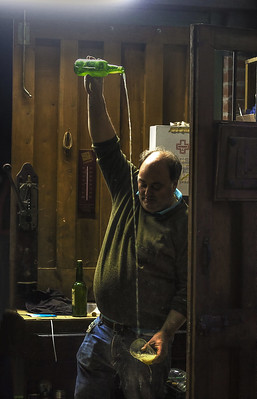
Escanciado is the traditional Spanish way of pouring cider that involves the decanting of a still cider (or Sidra Natural as it is called) from a bottle or barrel directly into the glass from a considerable distance!
The force exerted by the cider hitting the glass mixes in gas bubbles, which makes the cider instantly fizzy!
If you want to taste a good still cider, they will not be hard to find in the cideries of Asturias, but here are a couple of good Spanish still ciders worth mentioning:
1. Cortina’s Villacubera Tradicional. A traditional blend of regional apples fer,emted fpr 14 months with the wild yeast present on the apples. Acidic green apple notes with a tannic pineapple aftertaste.
2. EL Gobernador’s ESPANAR. Made from the bittersharp Regpna. Raxao and Blanquina apples give an explosion of taste in your mouth with a very slight fizz when poured fresh.
3. Menédez’s Val D’ Ornón. Made with similar cider apples to other ciders in the region including Raxao, Regona and Durona and fermented in Chestnut casks. It has a sharp tannic taste with a light fruity finish.
4. Bereziartua’s Sagardo Naturala, 2017. A special mix of 25 different apple varieties of the Basque Country region. Fermented and aged in steel tanks and wooden barrels, this cider has very little tannic tastes but a sweetness like a Riesling wine and zesty aftertastes.
5. Isastegi’s Sagardo Naturala. Another great naturally fermented still cider from the Basque Country. Seven different cider apples including the special Errezil variant. Dry and tangy with cox and pear notes. Lots of tannins.
All these ciders are within the same category of natural ciders with nothing added to them. Only the wild yeasts present in the apples do the work of fermentation.
The conditions vary between the cider types, but they often go through a period of ageing on wooden chestnut barrels as traditionally done.
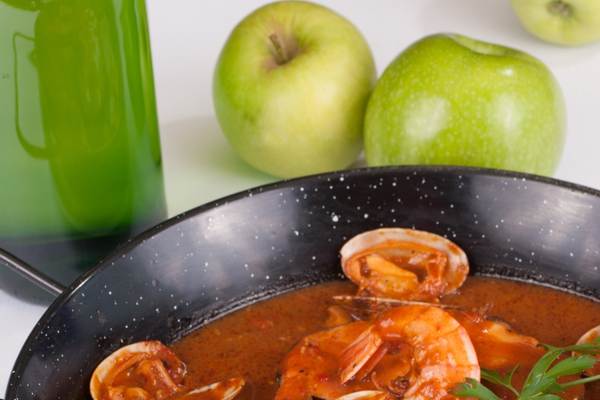
Although people mostly drink carbonated ciders in the remainder of the world, Spain is not the only country making non carbonated ciders.
What are some non carbonated hard ciders made in the US?
Yes indeed! Whereas most ciders in the US has carbonation, there are a number of small cideries making still ciders as well.
There are several brands and types of still cider available in the US. Some still ciders are sweetened with honey or syrup whereas others are dry.

Still apple cider is often sold by companies that make sparkling ciders as well, and to my knowledge, there are no cideries dedicated to still ciders in the US.
Below is a list of my favorite still cideries and their best still ciders available in North America:
1. Rose Hill Ferments’ Hitherto: A dry, tannic cider with a hearty dose of oak, aged one year in barrel, then one year in stainless and another year in bottle.
2. Farnum Hill‘s Still Cider: Very dry, with fresh acidity and a pleasant sharpness.
3. Alpenfire‘s Discovery Trail: A rosé cider made with organic Almata, Pink Pearl, Airlie Redflesh and Dolgo Crabapples.
4. Eden Cider’s Cinderella’s Slipper: A blend of estate-grown apples from Eden’s biodynamic orchard, aged 18 months in the bottle.
5. Eve’s Cidery’s Albee Hill: A huge blend of apple varieties, blended for texture, aroma and acidity.
6. South Hill Cider’s Goldwin: A blend of Golden Russet and Baldwin apples as a still apple wine.
7. Black Diamond Cider‘s Solstice Still: A blend of Porter’s Perfection, Kingston Black and Callville Blanc, with a smoky, earthy, complex flavor.
8. Liberty Ciderworks‘ Porter’s Perfection: Made with the bitters-harp varietal of the same name, which lend a mild bittersweet funk on the nose, and dried pear, ginger spice and grassy notes on the palate with a strong tannic finish.

9. Liberty Ciderworks’ Splintercat: An uncarbonated cyser (a cider-mead hybrid) made with Dolgo crabapples and local honey. It’s rich, full-bodied and sweet-tart, with berry, citrus and honey notes.
How to make non carbonated cider
Making non carbonated, or still, cider is actually easier than making sparkling cider! You just need to mix apple juice with yeast and be patient.
The main difference from making sparkling cider is that you do not add sugar to the fermented juice before bottling.

In this way you avoid the production of CO2 on the flasks and therefore prevent carbonation.
A word of caution though: You have to be very sure that the fermentation is done before bottling your cider, so rather wait a few weeks extra than one to little!
If you want a sweet still cider, add extra sugar to the initial must and use a yeast with a low alcohol tolerance e.g. just the wild yeast present on the apples.
Ingredients:
- 1 Gallon of apple juice (preferable freshly pressed)
- 1 package of cider yeast or add nothing if using freshly pressed apples (wild yeast!)
Optional:
- 1 teaspoon of yeast nutrient
- 2-3 drops of liquid pectin enzyme to clear the brew
Equipment:
- 1 clean, sterilized Fermentation Lock and airlock (or a balloon and a small length of tubing)
- >1 Gallon Glass Carboy or plastic bucket with lid (or any vessel that can hold at least 5 quarts with a small opening for an airlock).
- Racking Cane and Siphon Hose (or a long clear, flexible, plastic tube)
- Some clean, sterilized bottles with lids or crown caps.
You can read more about the total equipment and its cost compared to buying commercial cider in this post.
Procedure:
Sanitize all equipment thoroughly before beginning with boiled and slightly cooled down water.
To make the must, mix together the apple juice, sugar if needed for extra sweetness and yeast + yeast nutrient in the gallon container.
If using fresh pressing from whole apples, you may also want to add 2-3 drops of liquid pectin enzyme to help break down the pectin in the apples which will otherwise make your cider cloudy. Attach fermentation lock to container.
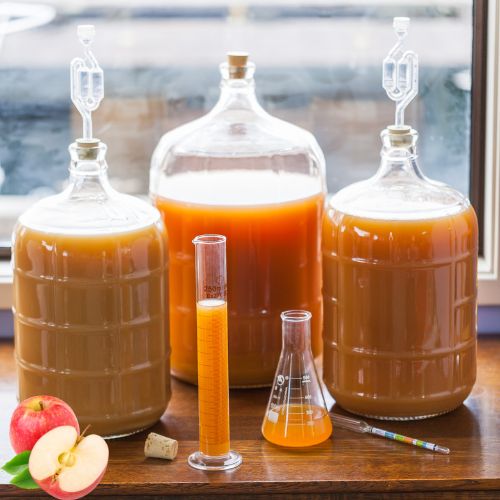
Fill the air lock halfway with water. Leave to ferment in a cool, dark place for 3-4 weeks, until bubbling has slowed and cider is no longer actively fermenting. The fermentation time and temperature depends on the yeast and the desired speed of fermentation.
You can check this by looking at the surface of the cider or the airlock. When fermentation is complete there should be a layer of sediment on the bottom while the top is mostly clear and no more bubbles are emerging.
If needed, let the cider sit for another week or so until completely clear before transferring it to your preferred cider storage containers.
To bottle, siphon cider into clean bottles leaving sediment behind.
Wipe bottles down with a clean cloth dipped in vodka to remove any potential bacteria that may have been transferred during siphoning. Seal bottles tightly and store in a cool dark place until ready to drink. The longer the cider gets to age, the more nuanced it tends to get.
If you later wish to carbonate the cider, you can simply use a SodaStream or other methods I go into here.
Conclusion
While most people think of hard cider as a bubbly, carbonated drink, here I have discusses the history and popularity of non-carbonated, or “still” cider.
Still cider is made without secondary fermentation or force carbonation, and it was the primary form of cider consumed for hundreds of years before technology advanced in the late 17th century.
Today, still cider is enjoying resurgence in popularity among craft breweries worldwide. Some believe that still cider brings out more of the nuanced flavours of the apples used, making it a unique and delicious experience on par with many fine wines.




